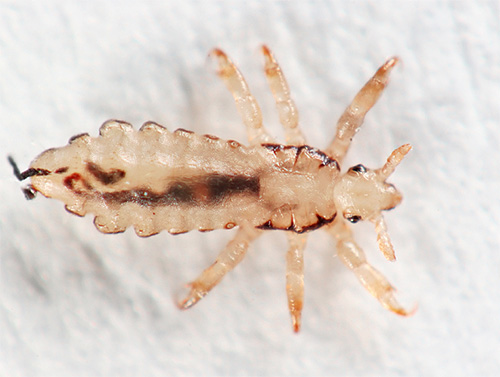
Head louse is a well-known and quite specific human parasite. This insect "chose" the scalp of the head for its habitat, successfully infecting both adults and children, and therefore, in general, head lice are considered more common and numerous than the other related species, pubic lice.
In addition to humans, head lice cannot parasitize on any other animals.. The reason for this is a very high degree of adaptation of lice to habitat and reproduction on the human hair, and such exceptional adaptability is manifested both in the appearance of the lice and in the features of their biology as a whole.
Below in the photo - close-up head lice:

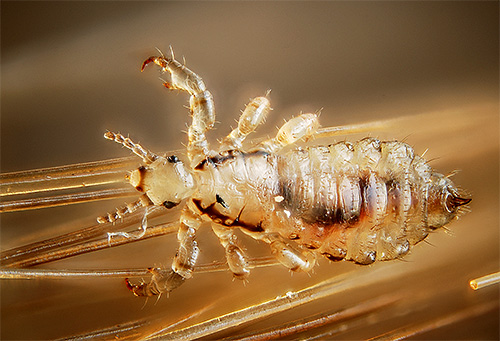
It is interesting
Pubic louse in the past few decades has become quite rare, and many experts even believe that it may soon become an endangered species.This is connected with the improvement of sanitary conditions of life of an increasing number of people, as well as with the popularity of pubic “bikini” haircuts, due to which lice, in principle, lose their normal habitats. But the fashion for shaved heads was not particularly popular, and therefore normal habitat for head lice is found almost everywhere where there are people.
An interesting evolutionary phenomenon was the emergence of a separate form of a head louse, which moved to clothes, and moved to a human body only for feeding - this is the so-called hanging louse (otherwise, a clothes louse). For many centuries that people wear clothes, this form of the parasite has managed to acquire some changes in the structure of the legs and the general lifestyle, which allow it to feel great on clothes.


In laboratories, head and lice are able to successfully interbreed and produce fertile offspring. However, under natural conditions on the human body, they are almost always isolated from each other, and therefore over time they become less and less similar to one another.
It is interesting
Dividing the head louse into two forms is a unique precedent that allows scientists to observe in real time the process of formation of a new insect species.It is even more interesting that it is precisely human activity and the appearance of clothes that is the main condition for the separation of wound lice. It is quite possible that head and body lice will take quite a bit of time to become completely different species - in this case, it will be possible to safely say that the person involuntarily gave birth to a new parasite.
Knowing well how lice look on a person’s head, one can be able to determine the presence of parasites before they cause a lot of trouble. Below are some pictures of head lice, as well as nits, which are usually the first to catch the eye on an infected head:



Feedback
“When Dasha first brought lice from school, I was shocked. In my very childhood, my parents brought out lice, but I thought that today this problem is no longer relevant at all. It turns out that lousy children regularly appear at school, especially after the summer holidays. The first few weeks the lice are not visible, and then the child begins to scratch his head, his white dots appear. This is nits. And the child is embarrassed to say that he has lice - everyone will laugh. These are usually not allowed to cure even to school. It is good that it is easy to display them.I took Medifox, did everything according to the instructions, and for three more days I combed out Dasha's hair with a special comb. But if something happens somewhere in the village, then you need to use kerosene, and this is dangerous - the child can spoil the hair. It is good for parents with boys, they can just shave the child’s head, and all problems will be solved by themselves. ”
Anna, Novosibirsk
How does the head louse look: photos and pictures
The head louse is a small insect. The body length of an adult individual is 2–4 mm, and for a nymph (the so-called louse larva) it is from 0.7 to 2 mm. Lice have a light brown color, which allows them to successfully mask themselves on the scalp and hair.
The photo below shows adult head lice and a few eggs (nits):

After the body is saturated with blood, the louse turns red:

Lice have no wings, and they cannot fly or fly far. But at the same time, the lice move rather quickly through the hair and scalp, so that even with short contacts the hair of different people have time to move to a new victim.
Feedback
“My Vanya picked up the first time lice at two years old - he didn’t go to kindergarten at that time and got infected, probably from some of the children on the street where we all walk together.I was already shaking all over when I saw them. Such a shit! I also thought that together with the lice, the fleas were sitting — the ones that were white, they were lice, and those that were red were fleas. Only then it dawned on me that the red ones are lice, only with blood in the stomach. God, I had a tantrum then, well, my mother-in-law was nearby, and she calmed me down, and quickly did everything - went to the drugstore, bought medermic water, and then sat in the bathroom with Vanya while the lice were poisoned ...
Albina, Moscow
Head lice have a rather characteristic body shape - an elongated abdomen and legs held forward. With the naked eye, the lice on the head look like small ants, but on closer examination it can be seen that they have a more massive belly. In the photo below you can see what a head louse looks like with a high magnification under a microscope:


Lice larvae (nymphs) are lighter and are characterized by translucent body covers. Due to this, after saturation with blood, a dark spot appears in the center of their abdomen - translucent stomach contents. From adult lice nymphs also differ in smaller sizes.
Below are some more photos of head lice:


It is interesting
The structure of the body of a head louse is typical of insects, but it also has features. Its legs have clawlike segments at the end, which allow the insect to easily wrap a bunch of hair. The head louse is visible in the picture at high magnification: there are small antennae on its head, and the belly of the insect has jagged edges. Interestingly, lice have underdeveloped eyes, and from their sense organs they rely mainly on the sense of smell.

But especially known nits - louse eggs. They are quite small - a little more than half a millimeter in length - and the lice are stuck on the hair by the female. Actually, it is the nits that first of all catch the eye, and therefore it is easiest for them to determine that a person is infected with lice.

Feedback
“I was the first who did not see lice in a child, but in their poop. A nightmare, I thought, it’s just some kind of garbage, but he’s always appearing. Such tiny black dots, that if the hair was thicker, they would not have noticed. She started poking around at Lidochka in her head - and found it. First nits on the hair, and then the lice themselves. Disgusting sight - they are so white, translucent. I do not know how other mothers after that still read something on the Internet, find out.Within ten minutes I bought a shampoo at a pharmacy to bring this dirk from my daughter ... ”
Elena, Yaroslavl
Head lice in children look exactly the same as in adults. In many cases, it is from children that adults infect these parasites in kindergartens, schools and recreation areas.
When infected with lice, the head often takes on a characteristic sloppy look. No matter how inconspicuous the head lice are, their nits with a large number are immediately noticeable - they look like dandruff or just white sand in the hair.
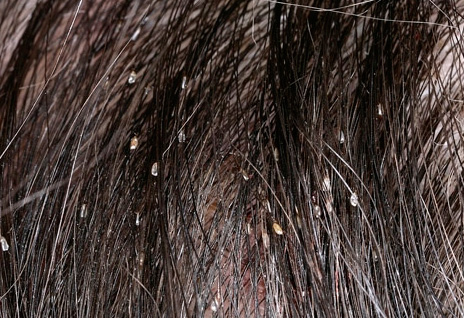
The following photos show what the head louse and nits look like on the hair:


Lice differ from other parasites primarily in size - the mites and bed bugs are larger than them (the small larvae of the bugs, which also have translucent chitinous integument of the body, are somewhat similar). Fleas, a little like lice, jump well and never breed on the head.
In general, lice infestation is sometimes more like not the presence of parasites on the head, but rather a certain skin disease — parents often confuse the symptoms of the presence of lice in a child with allergies.
The photo below shows the lice on the baby’s head:

Lifestyle and eating habits
Human head louse - typical hematophagus. In other words, the only food suitable for this parasite is human blood. The louse sucks it, piercing the skin and the blood vessel wall with a special mouth organ.
It is interesting
Close relatives of head lice are eaters in animals. They feed on both the blood and secretions of the skin glands of their owners, as well as pieces of dying skin. It is generally easier for these parasites to feed on blood than head lice, since most animals have hair covered with skin areas with a large number of blood vessels under it. On the human head, blood vessels are not equally readily accessible everywhere, and therefore lice are usually the most numerous in the neck and behind the ears.
At one time, a louse sucks about 0.5 mg of blood, and should be fed every four to five hours. When sucking blood, the louse injects saliva into the wound, the enzymes of which interfere with the coagulability of the blood and facilitate its flow over the insect's trunk. These enzymes in many cases cause the appearance of characteristic blue spots in the areas of louse bites, as well as allergic reactions in the victim.
The photo shows how the lice look on the head during a bite:

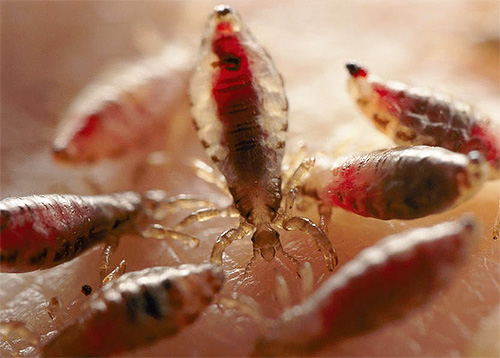
Feedback
“We have long noticed that the little one is constantly scratching his head, but we thought it was dandruff or some kind of allergy. I even bought medicinal shampoos for him. Once on the skin in the hair noticed some grayish spots, and then read that such lice leave. I started looking for - and really, it was lice. There were not many of them, but they came across, and there were nits in the hair. Before that, I had never known how the lice look on a child’s head, but here they were sitting somewhere in the hair ”.
Lydia, Rostov-on-Don
The video below shows how the circulatory system of the head lice functions (under a microscope):
Interesting video: lice circulatory system
The optimal temperature for lice is 31-32 ° C, which is maintained precisely in the dense head of the person. At this temperature, the louse dies without food for 2-3 days, and when the temperature drops to + 10 ° C, it can fast for up to 10 days
It is interesting
Lice are resistant to hypoxia and can survive up to two days, falling into the water. Therefore, it is impossible to kill the parasites by washing the hair, as well as strangle them by diving under the water.
Lice on the head of a person live constantly, without changing its location. Unlike other parasites crawling on the human body just for feeding,head lice have adapted to the constant presence on the head, and therefore they are very sensitive to both temperature extremes and fasting.
Here are some more photos of lice and nits on the head:


It is interesting
Another parasite that has moved on to complete dependence on the human body is the itch mite. To solve the problem of egg preservation, it is embedded under the skin and there it lays its eggs.
Adult lice live about 30-40 days, and the larvae develop for about 15 days. With a decrease in the temperature of the habitat, these periods increase.
Lice on the head are kept mostly near the roots of the hair, in the zone of the highest temperatures. Only their females to lay eggs crawling up the hair, climbing to a height of 2-3 cm from the skin. In general, the parasite feels more confident on the hairs, to which it can cling very tightly. In this position, the head louse (and especially the little nymph) looks just like a small growth and is difficult to see.

Feedback
“I don’t know where these all the doctors on duty in the camps are looking at - both I and three friends of the children came from the camp with lice. And they don’t even need to look for them in the hair - the whole hairstyle is as if powdered with snow, on each hair hangs on the nits. That's terrible.I called the organizers of the trip, stuffed everything there, said that I would be complaining to the SES for the whole camp. So they apologized then everything in turn, from the director to the driver of the camp bus. They sent me a box of chocolates and some lice cream. No, well, not a mockery? ”
Lily, Odessa
Breeding head lice
Lice lay nits right on the hair. Thanks to the sticky secret, which quickly hardens in the air, the egg adheres strongly to the hair, which ensures better safety of future offspring. Some lice products, including vinegar and cranberry juice, soften the adhesive, making it easier to remove nits from the hair after this treatment.
Each female in her life lays about 100-120 eggs, about 4 eggs per day. The development of the egg lasts 5 days, and the larva that emerges from it grows for about 15 days. The larva is very similar to the adult insect and differs from it only in the absence of genital organs and smaller body size.
Below the photo is clearly visible what lice eggs look like on the head (nits):

The whole breeding cycle at 32 ° C lasts about 18 days, minimum - 16. Its duration is influenced by temperature (on short hair in the winter, the development of nits cangenerally stop, and the whole cycle to stretch for months), and the availability of food. It is known that in people suffering from dermatological diseases of the scalp with the formation of dense crusts, lice development lasts longer.
The picture below shows the life cycle of a head louse:

Methods of transmitting head lice and their distribution among people
Head lice are transmitted from person to person, usually through direct contact. These can be children's games, sex, kissing at a meeting, hugs, contact sports.
It is characteristic that lice actively infect a new person, even if their number in the carrier of parasites is small, and the symptoms of infection have not yet been observed. That is why the parasites are actively distributed in children's groups: until the lice on the child's head are found, he already has time to infect some of his friends.

It is interesting
There is a myth among the people that lice in a certain stage can be under the skin and not show themselves in any way until a person becomes very nervous. After the “nerves”, the parasites allegedly crawl out from under the skin and begin to multiply vigorously.Variations of this myth are many, up to stories about lumps filled with lice and parasites in the brain itself. With the advent of new knowledge, such tales have become more “scientific” - today lice under the skin cause cancer. Of course, such prejudices do not have anything in common with the real state of affairs - lice never penetrate the skin, and their activity does not correlate with the state of the human nervous system.
Much less often lice are transmitted on combs, headdresses, hair elastics and hoops, which are used by several people. And quite in exceptional cases, lice can be transmitted by water, accidentally being in the bath or pool.
The following photo shows the head lice next to the invisible:

Important!
Lice can move from the lush head of the infected person in public transport or in a crowd. Therefore, in such places should be cautious.
What are dangerous head lice?
The most common consequence of lice infestation is pediculosis. This is a set of symptoms caused by heavy lice bites. These symptoms include itching, bite marks, bluish spots on the skin, and allergic reactions.In advanced cases, a person develops pustular skin lesions and even pyoderma.

Head lice very rarely carry pathogens of infectious diseases. In rare cases, they cause typhus and so-called trench fever, but in recent years these diseases have been associated almost exclusively with body lice.
Lice do not tolerate AIDS, hepatitis and other diseases transmitted with blood and lymph.
However, the lice bites themselves and lice are extremely unpleasant phenomena, and when they first appear they need to start fighting parasites as quickly as possible. For information on how to do this correctly and not to harm your own health or the health of your child, read the other articles on our site in the section "How to get rid of lice."
Useful video: where do lice come from a child and what to do to destroy them
And so, in fact, looks like a huge amount of lice in the hair of a child

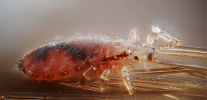
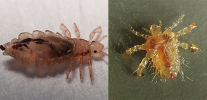
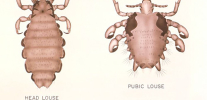
The child began to scratch his head a few days after the half-hour game on an inflatable ride. They jumped and rolled. More we are to this slides and trampolines a single step. We washed the head with a special shampoo according to the instructions. This drug is not cheap. Our pharmacy pharmacy is very familiar with our problem. It turned out that now the problem of lice has acquired a large scale.
I manage the kindergarten, in one of the groups lice appeared, in November, two children. Immediately held all the necessary activities, but did not announce quarantine, parents usually do not want publicity. All children were clean during the follow-up examinationsIn April, one of the girls had lice in the same group (and the same as in November). At home at the weekend, my mother told the tutor by phone. No lice were found in other children. The mother of the infected girl, together with another parent, complained to the kindergarten in the children's clinic, the education department, the city administration. In kindergarten, quarantine was announced, and they held the necessary activities, having spent considerable funds. And the child returned to kindergarten with a certificate confirming being in home quarantine (where is pediculosis?) All other children are healthy! The question arises: for what reason was quarantine?
Dear parents, be more careful about the health of your beloved children! Remember - these are your children, and no one except you will take care of them better than you. Love your children and do not shift the problems related to their health to educational organizations.
I now have these lice and nits.
Victoria, take it easy, you just need to trim the hair and buy a remedy for lice. Or you can not greatly trim the hair, and paint them. And the lice will disappear.
And if they were painted, and they did it several times with these means, but are they still there? (
Why do they live, these bastards? Only life is spoiled.
Then the balance in the world will be broken)
Yes, because they are also insects
I had lice, only children and one female, although I am 8 years old.
I had lice 2 times, generally scary
I had them "32" times, nothing terrible about it, just the head itches a lot. It's disgusting only if you realize that you have insects running around in your head 🙂
Exactly
My head hit the head lice, and even when I combed them, I ate one.
Are you crazy?
BROUGHT ONLY DICHLOPHOS! I found these reptiles at my daughter in the 3rd grade (in 2015), and for 9 years I could not even imagine what they were like and what they look like. She had been scratching her head a couple of months before the end of the school year, I bent her, looked under her hair, didn’t find anything, but when once again after washing her head she sat and scratched again, I was under a desk lamp - and then I was a little faint did not fall! And nits, and lice, it is under the lamp,but simply in the daylight they are not visible. And literally a couple of days before I was discovered, my mother painted her head, and found this creature with me, well, we crushed it and had no idea that it was louse, some kind of beetle thought. So, I rather ran to the pharmacy, bought the product, I do not even remember which one, on an oil basis. My hair was combed well with a lice comb, my daughters were combed all evening, then they did it for me, for my mother (grandmother). I did not do procedures for my husband, because He has a short haircut and I watched him, everything was clean. In the end they rinsed with diluted vinegar and ironing all gone. All week I scratched my daughter every night and found nits that click! Also, she ironed her once and held herself a couple of times, with a hot dryer, washing, ironing all clothes, bed, towels, and washing the floors. On the third week, again, the procedure of the daughter and me (grandmother lives separately, so she was only done one treatment, and grandmother did not initially find anything). After the third treatment week, the respite, and in the second week after the third treatment, I again found a small hatch that had just hatched. Again I bought shampoo against lice, all over again! I found a healthy louse again a week later, probably picked up from school.Then the grandmother says: try the usual Dichlorvos, and I decided from despair. Daughter sprinkled and covered with a package for 20 minutes. And also to yourself. After washing with shampoo, hot hair dryer, during the week not a single louse, and dry nits do not click)) A week later I repeated Dichlorvos for fixation - daughter for 40 minutes, and I for 50 minutes. And that's it! That's all, for the past two months of vacation, and my head is clean, I constantly check it now. And we did not have any allergies from dichlorvos, there were no irritations, everything is fine. And if you do not suffer from allergies, you can immediately try, the effect is 100%. And all these shampoos from the pharmacies did not help us, maybe our hair is thick - our friends have a daughter, the hair is thin, and they brought shampoo from the pharmacy the first time. I do not know what it is connected with, what helps one and not others. But DICHLOFOS for us turned out to be a miracle and salvation! I made a promise to myself that when I finish fighting these creatures, I will definitely write a review, because when she faced, she read a lot of tips and reviews, which helped me a lot in the fight. Do not lose hope! Everything will work out!
You have a whole poem.
Dichlorvos is very dangerous, especially under cellophane. Toxic state may develop. Once a child was seen (by a doctor) after such a procedure - toxic arthritis, all joints are affected, temperature, vomiting - horror. So I do not advise to apply.
It is easy to get rid of gasoline: it is good to moisten your hair with gasoline, preferably the very roots, cover your head with cellophane and tie a towel, walk for about 20-30 minutes. It will pinch the skin lightly, then go to the shower and rinse the head thoroughly with shampoo several times. Next, comb the hair over some cloth to comb all the corpses of these parasites. Next, wash your hair for 3 days with shampoo to get the smell of gasoline! Verified)
I am 12 years old. I had lice. In 2 class. My head was smeared with kerosene and everything was cleansed, only the head was burning, this is n * n! But I do not recommend it, because no matter how much my head is washed, it will stink, and the skin will peel off ... Lice are evil.
Yes, a little pleasant. And shampoo does not help, but dichlorvos exactly helps, only carefully, dear mommies. It is better to splash into a vial, dilute with water and apply with gloves so that there is no burn, God forbid.
Vasche horror, fu. I have never had lice, I am 11 years old, oh how scary!
And I have a problem at all: how can I not come from school, lice immediately appear. This is such a terrible thing, they can only be removed with Dichlorvos and hair dye, it helps me the most.
In childhood there was such a case. It's horrible. It is also a shame in front of people. Helped dichlorvos.
Kerosene helps, 40-50 minutes on the head a plastic bag, then several times washes from the smell of a simple shampoo. Not as stinky and as dangerous as gasoline. And gas is tin.
My child is 12 years old, we do not know where these nits came from, the story is terrible! The school nurse with the entire class found (according to her daughter) shame, shame and horror. Brought out all summer, I am 20 years old and not once did they not exist! How to fight, tell me? Kerosene, dichlorvos, paint and various shampoos and sprays do not help. Haircut for baldness refuses. I am ashamed to say. Tell me please!
Nastya, you gave birth at the age of 8?
I am 10 years old, I have had lice 7 times.
For two months my head itches, I thought seborrheic dermatitis, allergies, well, maybe bugs in feather pillows ... But today I caught one, then the second louse.I thought I had some kind of beetle (sifted flour before this, I also found a beetle there). Googled, oh-oh. Considered under the lamp - full head of eggs. From where I have no idea.
Lord, what can I do, these lice do not pass. I tried everything, nothing happens, and I’m afraid to come to school, the checks are in the same place, they’re looking.
Who knows? Is it enough to wash clothes and bedding in order to protect yourself from the spread of lice in the future? (with the head it is clear that we will process, but with personal things how to be?)
She caught a huge louse, immediately checked out her daughter. She has too. Bullet rushed to the pharmacy. I bought something very expensive, which was given in a pharmacy. Both were smeared, all according to the instructions. The next day I caught it again, such a lively and nimble one. She ran back to the pharmacy, bought something more expensive. Spent a lot of money. As a result, they appeared again. I was advised simple Chemeric water. Handled her. Now I’m waiting for fear that they will appear again. I did not think that in our time it is so difficult to get rid of them.
A person who has become infected with lice is not at fault.
I have lice, nothing helps me. Tell me something strong.
I am now 15 and this is the 2nd time I have lice. Right now I have them. My head was constantly itching, but my mother and grandmother looked at my head and did not find anything. And here I sit and scratch my head, then I notice that there is something under the fingernail, I have taken a closer look - and this is louse. I wanted to check and click, but she fell. But according to the description it is. And now I'm sitting, popshikannaya dichlorvos with a plastic bag on his head.
Try pedikulen, sleep on a towel all night, I have so gone. It is not necessary to cover anything, in the morning wash it with ordinary shampoo and comb it off with a frequent comb, starting from the hair roots.
I have yellow lice, tell me what to do?
I caught my son, he was 11 years old, he brought out a dust. Stinks and what to do. First, I trimmed it baldly and added vinegar to the wash.
I had lice, they were quickly brought out. But when combing with a comb, there are some black dots on it, and I don’t know what it is. The Internet writes little about it: someone - that it is louse excrement, others - that it is like lice that is not revealed, something like that.We urgently need to find out what it is and get rid of it, because it’s very scary. And you need to quickly, because after a day go to the competition.
My daughter has the second time. We started with Pedikulena, but this is just hard (screamed so that there was no strength to listen, it was very burning). Now smeared with some oily garbage. We'll see!
In Soviet times, there was a grandmother's way: after washing your hair, comb a small comb (a bone comb — there used to be such, comb teeth did not break), and to kill lice and nits directly on the head, clicking them.
In the morning I sent my daughter to a dance, and she sits and scratches her head, suffers. I thought I was just indulging. Then, I think, I will see, and there these larvae. I now have a hysterical, damn, what a mother I am, that I have a child with lice!
Lice - it's terrible, I have them now.
What to do, how to get rid of them?
Lice are some kind of capsidas, when I saw the pictures, my head was spinning at once ...
A week ago, I brought it out, and yesterday I found it again with my daughter. I am very worried about those who walked with us!
Lice - this is the norm.I even like it.
I am 18, my sister brought these reptiles from school (14 years). I thought I had dandruff and because of this my head itches. But when the “nymph” remained under my fingernail, I realized that the matter was bad. That was 2 weeks ago. Lice only at her and me, thank God, no one else thought of sleeping on her bed (90% that I picked them up from her pillow). Today, without a second thought, I decided, after washing my head, to comb my hair with a fine comb. It left 2 of these creatures! I had a guy on the weekend, he now also has a family in danger. Lice, see you in hell! You can't be anywhere else! But spoil my life.
Hygienic helps, costs around 200 rubles.